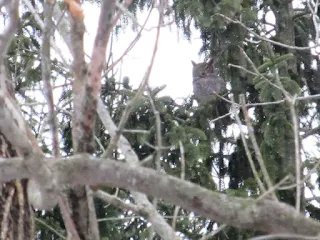The following pictures are of area "F" starting from the the east end of the "handle" of the frying pan.
 |
| Dead and fallen ash. Much light starting to hit the forest floor. A great opportunity to add some diversity. |
 |
| More dead and fallen ash |
 |
| A shot showing the slope of the east side of the swamp. And another fallen ash. |
 |
| The previous owner 1950-1975 never cut a tree. Nor did he ever trim one. The multistemmed tree is a Swamp White Oak (Q. bicolor) |
 |
| Mid way on the handle, looking to the northwest. |
 |
| A tiny bit of color on a dreary day. American Bittersweet. |
 |
| One of the consultants is very excited about using "hinge cuttings" to increase cover. In practice, the canopies become covered with vines and form tents. These vines are wild grape (V. riparia) |
 |
| Another "tent". This one is too high to be used by deer. |
 |
| A sedge meadow. Still in F but getting very close to the frying pan. |
 |
| A couple of shots from 12' above the ground looking into the frying pan. |
 |
| A Black Walnut with miserable form. |
 |
| Some Northern Red Oak with decent size. The one in the middle is about 24" diameter. |
 |
| Some 100' wide checkerboard squares of Blue Spruce (on left) and Norway Spruce (on right). Pine had been planted in the empty squares but deer destroyed them. |
 |
| One of the high points of the day. There is a pair of Great Northern Owls nesting in the Norway Spruce. These shots are of the same bird. |
 |
| A test run on some hinge cuts. Black Locust. |
 |
| A pile of Black Locust logs. |
 |
| Near the west edge of the frying pan looking south. You can see "D" rising up in the background. |
 |
| From the same vantage point looking southeast. On right side of photo in the midground you can see standing water with "soft maple". |
 |
| The current owner planted a Bald Cypress at the edge of the standing water. It did well. |
To be continued.





Bald Cypress that far north?? outstanding.
ReplyDeleteBald Cypress is common as far north as Southern Indiana. It occurs sporadically, as a native, in pot-holes as far north as central Illinois.
ReplyDeleteThere are some old Cypress in Eaton Rapids that are probably planted but nobody has records.
It is fully winter hardy here.
For whatever reason, Bald Cypress was not very effective chasing the glaciers as they retreated. It may be that the cones need longer to ripen. It may be that the first year seedlings need more warmth before they germinate.
The point is that they grow well if a human plants them.
Is the SWO from stump sprouts?
ReplyDeleteEither stump sprouts, fire damage or deer browsing destroyed the central leaders.
DeleteIt is not obvious to me.